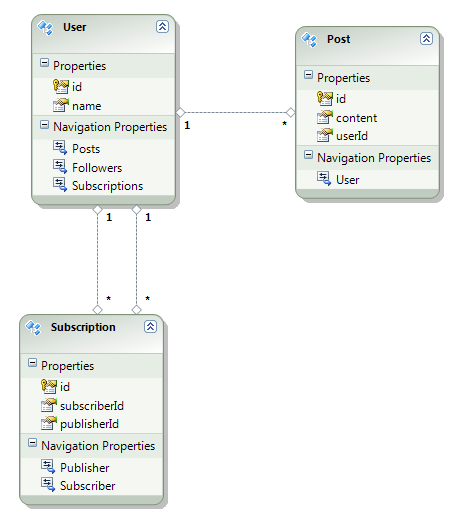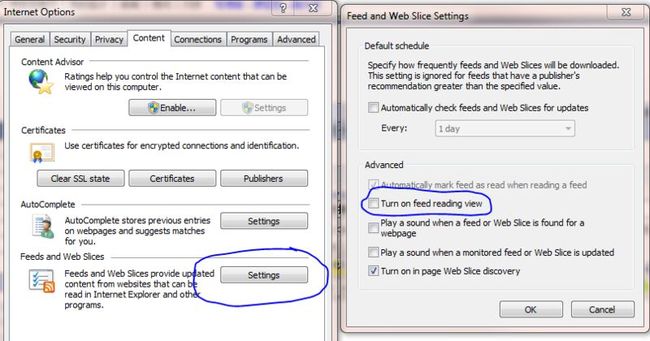oData - 另一种不用写代码就在网上提供数据服务的方法
先看两个例子:
- 最大的地摊平台 eBay 的目录服务:http://ebayodata.cloudapp.net/
- 北美最大的网络电视供应商 NetFlix 的目录服务:http://odata.netflix.com/Catalog/
这里还有更多提供/支持这种服务的链接:http://www.odata.org/blog/2010/10/28/new-odata-producers-and-consumers
这是什么?
开放数据协议(oData)让你重新认识 HTTP 协议并且简化数据在网上的发布和更新过程。参看在 cnblogs 查到的唯一介绍它的新闻:http://news.cnblogs.com/n/69756/ 和一篇写在 VS 2010 RC 时候的简介:http://www.cnblogs.com/shanyou/archive/2010/02/11/1667381.html
说正题: 用 VS 2010 + .NET V4,几乎可以不用写代码就把完整的数据服务发布到网上。步骤如下:
假设你已经有一个数据库,用户可以发围脖和订阅别人的围脖,数据结构如下,
要把它变成一个网络数据服务:
1、在VS 2010 建一个Web应用或网站,加一个数据模型:
2、把数据库里的表加进来:
 |
把默认生成的关联属性名字改改,改好就像右边这样: |  |
3、加一个新的 WCF Data Service 网页:
4、打开它的 CS 文件,
2 {
3 // This method is called only once to initialize service-wide policies.
4 public static void InitializeService(DataServiceConfiguration config)
5 {
6 // TODO: set rules to indicate which entity sets and service operations are visible, updatable, etc.
7 // Examples:
8 // config.SetEntitySetAccessRule("MyEntityset", EntitySetRights.AllRead);
9 // config.SetServiceOperationAccessRule("MyServiceOperation", ServiceOperationRights.All);
10 config.DataServiceBehavior.MaxProtocolVersion = DataServiceProtocolVersion.V2;
11 }
12 }
改成下面这个样子(基本上就是把注释去掉,把刚才的数据模型加进来):
2 {
3 public static void InitializeService(DataServiceConfiguration config)
4 {
5 config.SetEntitySetAccessRule( " * " , EntitySetRights.AllRead);
6 config.SetServiceOperationAccessRule( " * " , ServiceOperationRights.All);
7 config.DataServiceBehavior.MaxProtocolVersion = DataServiceProtocolVersion.V2;
8 }
9 }
5、没了,你的数据服务已经在网上。
浏览你的SVC网页,可以看到:
2 < service xml:base ="http://localhost:38791/messages.svc/" xmlns:atom ="http://www.w3.org/2005/Atom" xmlns:app ="http://www.w3.org/2007/app" xmlns ="http://www.w3.org/2007/app" >
3 < workspace >
4 < atom:title > Default </ atom:title >
5 < collection href ="Posts" >
6 < atom:title > Posts </ atom:title >
7 </ collection >
8 < collection href ="Subscriptions" >
9 < atom:title > Subscriptions </ atom:title >
10 </ collection >
11 < collection href ="Users" >
12 < atom:title > Users </ atom:title >
13 </ collection >
14 </ workspace >
15 </ service >
16
浏览service.svc/Users,可以看到用户列表:
< feed xml:base ="http://localhost:38791/messages.svc/" xmlns:d ="http://schemas.microsoft.com/ado/2007/08/dataservices" xmlns:m ="http://schemas.microsoft.com/ado/2007/08/dataservices/metadata" xmlns ="http://www.w3.org/2005/Atom" >
< title type ="text" > Users </ title >
< id > http://localhost:38791/messages.svc/Users </ id >
< updated > 2010-12-20T19:22:12Z </ updated >
< link rel ="self" title ="Users" href ="Users" />
< entry >
< id > http://localhost:38791/messages.svc/Users(1) </ id >
< title type ="text" />
< updated > 2010-12-20T19:22:12Z </ updated >
< author >
< name />
</ author >
< link rel ="edit" title ="User" href ="Users(1)" />
< link rel ="http://schemas.microsoft.com/ado/2007/08/dataservices/related/Posts" type ="application/atom+xml;type=feed" title ="Posts" href ="Users(1)/Posts" />
< link rel ="http://schemas.microsoft.com/ado/2007/08/dataservices/related/Followers" type ="application/atom+xml;type=feed" title ="Followers" href ="Users(1)/Followers" />
< link rel ="http://schemas.microsoft.com/ado/2007/08/dataservices/related/Subscriptions" type ="application/atom+xml;type=feed" title ="Subscriptions" href ="Users(1)/Subscriptions" />
< category term ="Message.DataModel.User" scheme ="http://schemas.microsoft.com/ado/2007/08/dataservices/scheme" />
< content type ="application/xml" >
< m:properties >
< d:id m:type ="Edm.Int32" > 1 </ d:id >
< d:name > Test </ d:name >
</ m:properties >
</ content >
</ entry >
</ feed >
总结
为什么叫开放数据协议?因为它跨语言和平台的,基于http地址的数据服务。
例子:
列出所有的用户:service.svc/Users
找一个叫张三的用户:service.svc/Users?$filter=Name eq '张三'
他发的围脖(假设前一个查询返回了他的ID):service.svc/Users(1)/Posts
他的Fans: service.svc/Users(1)/Followers
他发的关于cnblogs的围脖:service.svc/Posts?$filter=userId eq 1 and indexof(content, 'cnblogs') ge 0
这些看起来并不难,但好处是,它们都不需要写任何代码,而且它是RESTful的,任何可以访问URL的语言,平台都可以用它。除此以外,这只是GET操作,POST,DELETE等其他标准HTTP操作也是原生支持的。所以,它是完整的数据服务,并不仅仅是数据查询。
如果大家有兴趣,我会继续写这个主题,比如在WPF使用这种服务,在JavaScript使用(Built in JSON support, 哈哈),并涉及一些更深的,实际项目的内容,比如数据安全,数据事务。
题外话, 为什么是另一个?很久很久以前,SQL Server曾经有过Web Service 的服务,但M$做了一个艰难的决定,把它在后续版本中移除了。由于 Entity Framework, WCF data service in .NET V4的加持,这种服务又换了一个方式回来了。
题外外话,斗转星移,离上一篇文章又两年过去了,地方没变,人老了。
人老记性就不好,这个给忘了:要修给IE的一个设置,让它不自动 turn on feed view,不然你看到就是IE格式化过的内容了,odata返回的是,人也可以吃,IE也可以吃的 Atom xml.



